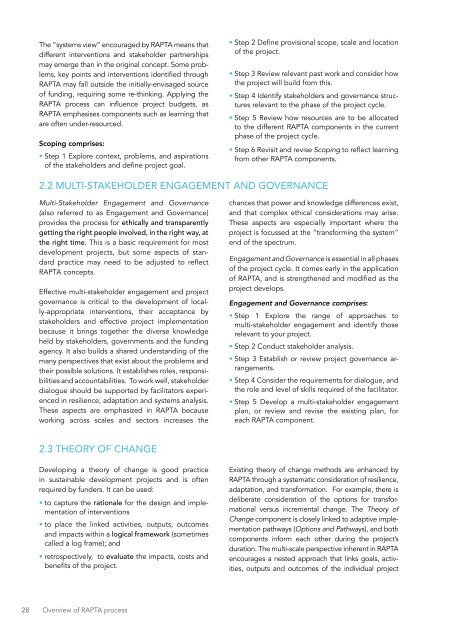DESIGNING PROJECTS IN A RAPIDLY CHANGING WORLD
srun3013fp1
srun3013fp1
Create successful ePaper yourself
Turn your PDF publications into a flip-book with our unique Google optimized e-Paper software.
The “systems view” encouraged by RAPTA means that<br />
different interventions and stakeholder partnerships<br />
may emerge than in the original concept. Some problems,<br />
key points and interventions identified through<br />
RAPTA may fall outside the initially-envisaged source<br />
of funding, requiring some re-thinking. Applying the<br />
RAPTA process can influence project budgets, as<br />
RAPTA emphasises components such as learning that<br />
are often under-resourced.<br />
Scoping comprises:<br />
• Step 1 Explore context, problems, and aspirations<br />
of the stakeholders and define project goal.<br />
• Step 2 Define provisional scope, scale and location<br />
of the project.<br />
• Step 3 Review relevant past work and consider how<br />
the project will build from this.<br />
• Step 4 Identify stakeholders and governance structures<br />
relevant to the phase of the project cycle.<br />
• Step 5 Review how resources are to be allocated<br />
to the different RAPTA components in the current<br />
phase of the project cycle.<br />
• Step 6 Revisit and revise Scoping to reflect learning<br />
from other RAPTA components.<br />
2.2 MULTI-STAKEHOLDER ENGAGEMENT AND GOVERNANCE<br />
Multi-Stakeholder Engagement and Governance<br />
(also referred to as Engagement and Governance)<br />
provides the process for ethically and transparently<br />
getting the right people involved, in the right way, at<br />
the right time. This is a basic requirement for most<br />
development projects, but some aspects of standard<br />
practice may need to be adjusted to reflect<br />
RAPTA concepts.<br />
Effective multi-stakeholder engagement and project<br />
governance is critical to the development of locally-appropriate<br />
interventions, their acceptance by<br />
stakeholders and effective project implementation<br />
because it brings together the diverse knowledge<br />
held by stakeholders, governments and the funding<br />
agency. It also builds a shared understanding of the<br />
many perspectives that exist about the problems and<br />
their possible solutions. It establishes roles, responsibilities<br />
and accountabilities. To work well, stakeholder<br />
dialogue should be supported by facilitators experienced<br />
in resilience, adaptation and systems analysis.<br />
These aspects are emphasized in RAPTA because<br />
working across scales and sectors increases the<br />
chances that power and knowledge differences exist,<br />
and that complex ethical considerations may arise.<br />
These aspects are especially important where the<br />
project is focussed at the “transforming the system”<br />
end of the spectrum.<br />
Engagement and Governance is essential in all phases<br />
of the project cycle. It comes early in the application<br />
of RAPTA, and is strengthened and modified as the<br />
project develops.<br />
Engagement and Governance comprises:<br />
• Step 1 Explore the range of approaches to<br />
multi-stakeholder engagement and identify those<br />
relevant to your project.<br />
• Step 2 Conduct stakeholder analysis.<br />
• Step 3 Establish or review project governance arrangements.<br />
• Step 4 Consider the requirements for dialogue, and<br />
the role and level of skills required of the facilitator.<br />
• Step 5 Develop a multi-stakeholder engagement<br />
plan, or review and revise the existing plan, for<br />
each RAPTA component.<br />
2.3 THEORY OF CHANGE<br />
Developing a theory of change is good practice<br />
in sustainable development projects and is often<br />
required by funders. It can be used:<br />
• to capture the rationale for the design and implementation<br />
of interventions<br />
• to place the linked activities, outputs, outcomes<br />
and impacts within a logical framework (sometimes<br />
called a log frame); and<br />
• retrospectively, to evaluate the impacts, costs and<br />
benefits of the project.<br />
Existing theory of change methods are enhanced by<br />
RAPTA through a systematic consideration of resilience,<br />
adaptation, and transformation. For example, there is<br />
deliberate consideration of the options for transformational<br />
versus incremental change. The Theory of<br />
Change component is closely linked to adaptive implementation<br />
pathways (Options and Pathways), and both<br />
components inform each other during the project’s<br />
duration. The multi-scale perspective inherent in RAPTA<br />
encourages a nested approach that links goals, activities,<br />
outputs and outcomes of the individual project<br />
28 Overview of RAPTA process


